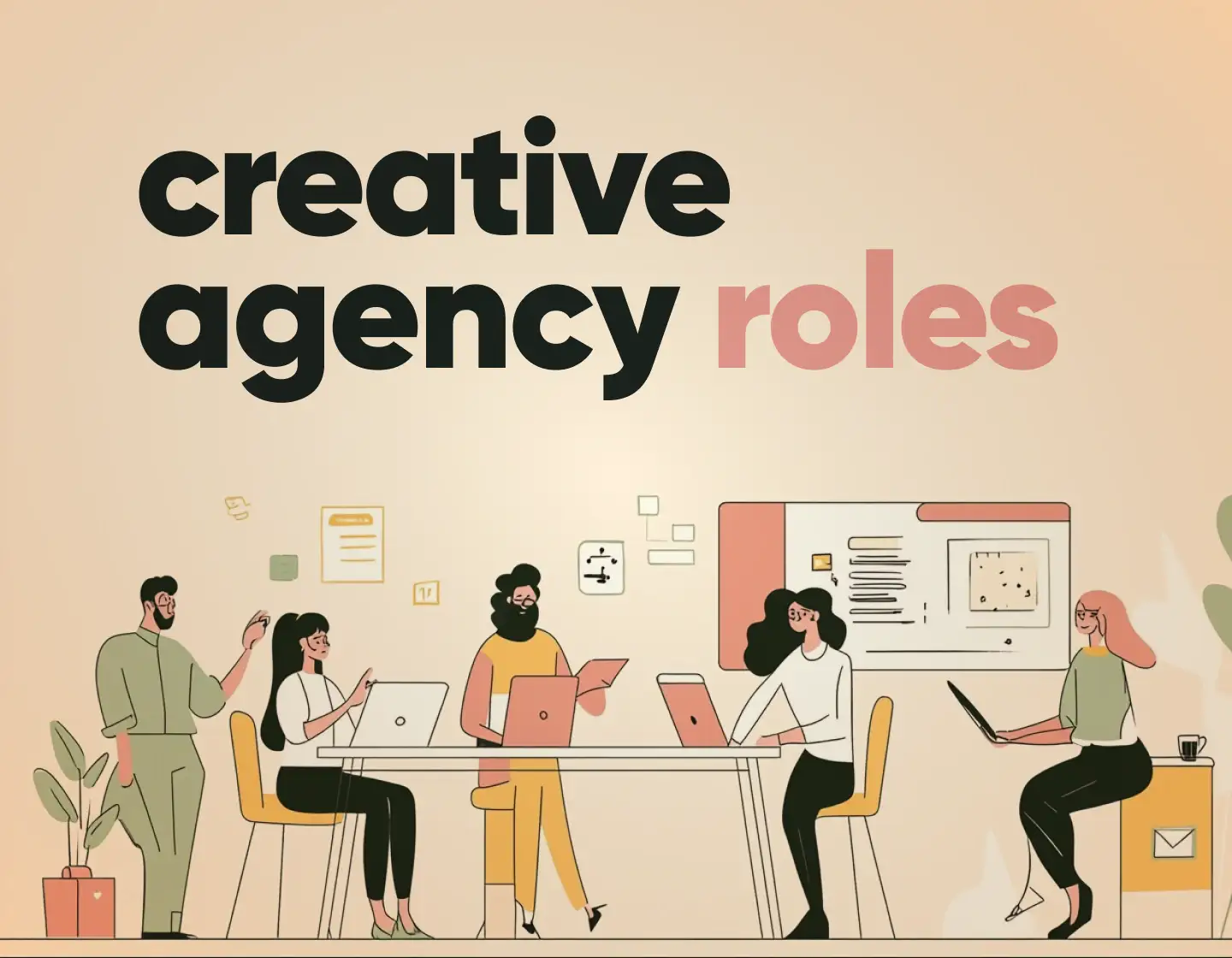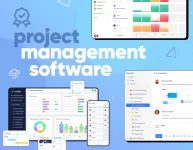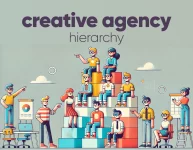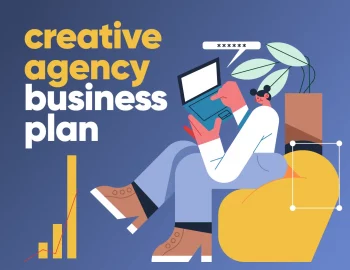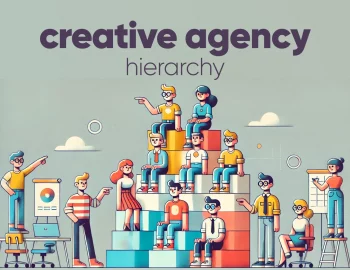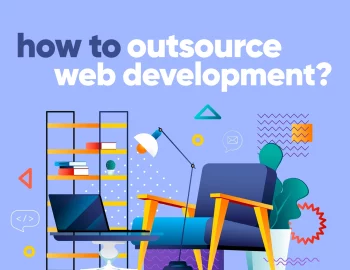Running a creative agency, or working in one, is surely exciting – there’s always something interesting going on, and every team member has his role in bringing client visions to life. But if you’re in the process of building your dream team or trying to fit into one, figuring out exactly who does what (and how all the moving parts fit together) can feel like solving a puzzle with missing pieces.
So, that’s why today, we’re breaking down the essential creative agency roles – what they do, who they collaborate with, the skills they require, and how they contribute to the bigger picture.
Let’s wait no more and dive into the lineup of experts who keep your agency running smoothly!
Creative Agency Roles: Who’s Who
Firstly I just have to say that not every creative agency employs all these roles. It all depends on an agency’s size, direction, and preferences. Also, many agencies get creative and use different job titles, so don’t be alarmed if you encounter a brand guru or a graphic design supreme commander. Now let’s see what a creative agency team looks like:
1. CEO/Managing Director
The CEO or Managing Director is the strategic leader of the agency, responsible for overall growth, business direction, and company culture. They make high-level decisions, manage finances, and ensure the agency is profitable while maintaining a strong creative vision.
How they contribute to the bigger picture: They set the agency’s long-term goals, build key long-term client relationships, and ensure that all departments align with the agency’s mission and objectives.
Who they collaborate with: Works closely with the CCO, Account Director, and Marketing Manager. Also oversees Project Managers ensuring operational efficiency, and engages with clients, investors, and stakeholders.
Key Skills: Strategic thinking, leadership and decision-making, business development and financial management, client relationship management, and communication and negotiation.
2. Chief Creative Officer (CCO)
The Chief Creative Officer (CCO) is the agency’s creative visionary, who ensures that all work aligns with the agency’s brand identity and high-quality standards. They oversee creative direction, set artistic goals, and drive innovation in branding, design, and marketing.
How they contribute to the bigger picture: The CCO ensures the agency produces impactful, original work that strengthens client brands while maintaining the agency’s reputation for excellence.
Who they collaborate with: Works with the CEO/Managing Director to align business goals with creative direction. Leads Creative Directors, Art Directors, and Copywriters and also collaborates with the Marketing Manager.
Key Skills: A deep understanding of creative leadership, brand storytelling, concept development, trends forecasting, and innovation. Strong communication and mentorship skills are also essential.
3. Marketing Manager
Although in bigger digital agencies the roles can be divided into a Marketing Manager and a Brand Strategist, most creative agencies employ only the first position. Thus, the Marketing Manager blends marketing strategy with brand development, ensuring the agency and its clients maintain a strong, consistent message across all platforms. They conduct market research, develop positioning strategies, and oversee marketing campaigns.
How they contribute to the bigger picture: They shape how brands – including the agency itself – are perceived, driving business growth and helping the agency’s clients establish a powerful market presence.
Who they collaborate with: Works with Account Directors and Creative Directors and collaborates with CCOs, Social Media Managers, Copywriters, and Designers to execute campaigns. Also engages with clients to refine branding strategies and messaging.
Key Skills: Expertise in brand strategy, market research, consumer insights, campaign development, performance tracking, and also strong storytelling and communication abilities.
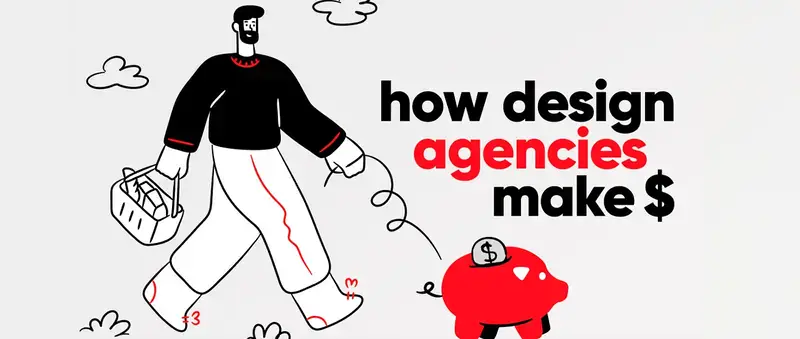
4. Account Director
The Account Director is the agency’s senior client relationship manager, responsible for overseeing client accounts. They act as a bridge between clients and internal teams, ensuring projects meet expectations and align with strategic goals.
How they contribute to the bigger picture: The Account Director helps retain clients, grow accounts, and position the agency as a trusted creative partner.
Who they collaborate with: Works closely with the CEO/Managing Director, manages Account Managers, and also collaborates with Creative Directors and Project Managers.
Key Skills: Expertise in client relationship management, strategic thinking, negotiation, communication, and leadership. A strong understanding of marketing, branding, and creative production is also essential to effectively oversee client accounts.
5. Account Manager
The Account Manager is responsible for the day-to-day management of client relationships. They serve as the primary point of contact for clients and then coordinate with internal teams to deliver high-quality work.
How they contribute to the bigger picture: Keeping creative projects on track and maintaining client satisfaction, the Account Manager plays a key role in both client retention and agency growth.
Who they collaborate with: They report to the Account Director and work closely with clients to understand their needs. Also, work alongside Project Managers and collaborate with Creative Directors, Designers, and Copywriters.
Key Skills: Communication, organization, problem-solving, and multitasking skills. A deep understanding of marketing and creative processes is also essential for effective client management.
6. Creative Director
The Creative Director leads the agency’s creative team, setting the artistic direction for projects and ensuring work meets the agency’s standards. They develop concepts, oversee execution, and mentor the creative team.
How they contribute to the bigger picture: Helps the agency produce impactful work that resonates with clients and their audiences.
Who they collaborate with: Works with the CCO to align creative direction with the agency’s vision. Also collaborates with Art Directors, Designers, Copywriters, and UX/UI Designers and engages with Project and Account Managers to ensure creative work aligns with client expectations and timelines.
Key Skills: Must have exceptional leadership, conceptual thinking, storytelling, and design expertise. Strong presentation and communication skills are also essential.
7. Art Director / Design Director
The Art Director’s role is responsible for the visual style and aesthetics of the agency’s creative output, guaranteeing consistency and quality in branding, marketing, and digital experiences. They lead design teams, set creative guidelines, and refine design strategies.
How they contribute to the bigger picture: Overseeing the artistic execution of campaigns and branding efforts, the Art Director makes sure the agency produces visually compelling and cohesive work that enhances brand identity and audience engagement.
Who they collaborate with: Reports to the Creative Director, leads and collaborates with Graphic Designers, UX/UI Designers, and Motion Graphic Designers. Works with Copywriters to balance visual storytelling with messaging and also engages with Project and Account Managers.
Key Skills: Strong conceptual thinking, design expertise, and leadership abilities. A keen eye for detail and a deep understanding of branding and storytelling are also essential for high-quality creative execution.
8. Graphic Designer
The Graphic Designer is responsible for creating visual assets for branding, marketing, and advertising campaigns. They design things such as logos, social media graphics, websites, packaging, and various promotional materials.
How they contribute to the bigger picture: The Graphic Designer plays a crucial role in bringing client brands to life and enhancing brand communication across platforms by translating creative ideas into compelling visuals.
Who they collaborate with: Works under the Art Director and collaborates with Copywriters to achieve cohesive visuals and messaging. Also works alongside UX/UI Designers, Motion Graphic Designers, and Project Managers.
Key Skills: Expertise in typography, layout design, color theory, and branding. Proficiency in design software (Adobe Creative Suite) and a strong understanding of visual storytelling are essential.
9. UX/UI Designer
The UX/UI Designer focuses on crafting seamless, user-friendly digital experiences, such as websites, web and mobile applications, and interactive platforms. They ensure intuitive navigation, accessibility, and a visually appealing interface.
How they contribute to the bigger picture: The UX/UI Designer enhances user engagement, helping brands build meaningful connections with their audience.
Who they collaborate with: Works with Creative Directors and Art Directors; collaborates with Developers; works alongside Copywriters, while engaging with Project Managers to balance user needs with project constraints.
Key Skills: A deep understanding of user experience principles, wireframing, prototyping, and interaction design. Proficiency in tools like Figma, Sketch, or Adobe XD is crucial, along with problem-solving and user research skills.
10. Motion Graphic Designer
The Motion Graphic Designer creates dynamic visuals, animations, and video content for digital marketing, branding, and advertising campaigns. They bring static designs to life through motion, thus enhancing engagement and storytelling.
How they contribute to the bigger picture: Helps brands capture attention, engage audiences, and convey messages in a visually compelling way.
Who they collaborate with: Works with Art Directors and Creative Directors; collaborates with Graphic Designers and UX/UI Designers; works with Copywriters to create engaging video narratives; and engages with Project Managers.
Key Skills: In-depth knowledge of animation, video editing, and visual storytelling. Proficiency in tools like After Effects, Cinema 4D, and Premiere Pro, along with a keen eye for movement and timing.

11. Copywriter
The Copywriter is the agency’s storyteller, crafting compelling written content that aligns with brand messaging. They create everything from advertising copy and web content to social media captions, taglines, and scripts.
How they contribute to the bigger picture: Shaping the brand’s voice and ensuring consistency across all communication channels, the Copywriter plays a key role in engaging clients’ (and the creative agency’s) target audiences and driving conversions.
Who they collaborate with: Works with Creative Directors, Art Directors, and Project Managers; collaborates with Graphic Designers and UX/UI Designers to align copy with visuals; crafts targeted messaging with Marketing and Social Media Managers.
Key Skills: Exceptional writing, editing, and conceptual thinking skills. A deep understanding of brand tone, audience psychology, and persuasive storytelling is also crucial for creating impactful content.
12. Web Developer
The Web Developer is responsible for building, maintaining, and optimizing websites. They ensure functionality, performance, and responsiveness while troubleshooting technical issues.
How they contribute to the bigger picture: Web Developers transform creative designs into fully functional websites, ensuring a brand’s digital presence is engaging, user-friendly, and technically sound.
Who they collaborate with: Works with UX/UI Designers and Copywriters; and collaborates with Project and Marketing Managers.
Key Skills: Proficiency in front-end and/or back-end development, coding languages (HTML, CSS, JavaScript), CMS platforms, and performance optimization. Strong problem-solving and debugging abilities are also important.
13. Project Manager
The Project Manager is responsible for planning, organizing, and overseeing creative projects so they can be completed on time, within scope, and on budget. They coordinate between teams, manage resources, and streamline processes to ensure smooth project execution.
How they contribute to the bigger picture: The Project Manager helps the agency deliver high-quality work efficiently and consistently while maintaining client satisfaction.
Who they collaborate with: Works closely with Account and Production Managers and Creative Directors; coordinates with all creative team members to manage timelines and deliverables and also engages with clients.
Key Skills: Excellent organizational and multitasking abilities, strong leadership and communication skills, and a deep understanding of creative workflows and project management tools.
14. Production Manager
The Production Manager oversees the execution of creative projects, ensuring all physical and digital assets are produced efficiently and meet quality standards. However, it’s fair to mention that this role is more common in mid-to-large agencies that handle complex multimedia productions.
How they contribute to the bigger picture: They guarantee creative work is executed smoothly, maintaining high-quality output and client happiness.
Who they collaborate with: Works with Creative Directors and Project and Account Managers to define production needs; collaborates with Content Producers, Photographers, and Videographers to coordinate execution, and oversees external vendors, printers, and suppliers.
Key Skills: Strong organizational skills, attention to detail, and expertise in production logistics. Negotiation skills and budget management are also needed for handling external partnerships.
15. Content Producer
The Content Producer is responsible for overseeing digital content creation, such as photography, video, podcasts, and other multimedia assets. However, this role is more often seen in creative agencies focused on social media and content marketing.
How they contribute to the bigger picture: Ensures the agency’s creative work is engaging and relevant across digital platforms, producing content that aligns with the marketing strategy.
Who they collaborate with: Work with Creative Directors and Social Media and Marketing Managers to align content with campaign goals while collaborating with Photographers, Videographers, Motion Graphic Designers, and Copywriters.
Key Skills: Expertise in digital content production, video editing, storytelling, and platform-specific content strategies. Strong project management skills are also essential.

16. Social Media Manager
The Social Media Manager develops and executes social media strategies, managing community engagement and content distribution across platforms.
How they contribute to the bigger picture: Helps amplify campaigns, attract new audiences, and enhance brand reputation.
Who they collaborate with: Works with Copywriters and Designers; collaborates with Marketing and Account Managers; and works alongside Motion Graphic Designers.
Key Skills: Expertise in social media trends, content creation, and analytics. Strong communication, creativity, and community management skills are also a must-have.
17. Junior Creatives (Creative Assistants)
Junior Creatives, or Creative Assistants, support the creative team by helping with design, content creation, research, and brainstorming. They gain hands-on experience while contributing to various projects across the agency.
How they contribute to the bigger picture: Allow the team to focus on high-level strategy and execution by handling smaller tasks and supporting senior creatives, thus ensuring smoother workflows and faster project turnaround.
Who they collaborate with: Work with the whole creative department, Project and Social Media Managers, and Content Producers to assist with diverse tasks; and also collaborate with Art Directors and Creative Directors to develop ideas and refine concepts.
Key Skills: One must be eager to learn, adaptable, and highly creative. Strong foundational skills in design, writing, or multimedia production are important, along with attention to detail and a willingness to take feedback.
18. Administrative Staff / Office Managers
The hero in disguise – the Administrative Staff ensures smooth day-to-day operations, handling office logistics, scheduling, HR tasks, and financial administration. This role is essential in larger creative agencies but may be handled by senior leadership or project managers in smaller teams.
How they contribute to the bigger picture: Managing office operations, budgets, and employee needs, the Office Manager creates an efficient work environment, thus allowing creative teams to focus on their projects without distractions.
Who they collaborate with: Works with CEOs and HR teams to manage administrative tasks; engages with Account Managers and Finance Teams to handle invoices and contracts; and supports all employees.
Key Skills: Strong organizational and multitasking abilities, excellent communication skills, and a solid understanding of office management, HR, and financial administration.
Tips on structuring teams based on agency size
As your agency evolves, the size of your agency and the types of services you offer will influence how you organize your team, so here are a few tips to consider:
Small Agency (1-20 Employees)
- Generalists Over Specialists: In small agencies, team members often wear multiple hats, thus allowing flexibility and adaptability.
- Cross-functional Collaboration: Encourage everyone to work across functions, fostering creativity and smooth workflows while helping team members grow.
- Streamlined Roles: Focus on core roles such as Creative Directors and Project Managers, that directly contribute to your agency’s main services, and skip non-essential positions.
- Flat Hierarchy: A simple structure is suitable here because it allows for quick decision-making and easy communication.
Mid-Sized Agency (20-50 Employees)
- Specialized Teams: Start developing distinct creative, account, and production teams with specialized leaders for each group.
- Division of Labor: While people in the agency can still wear a few different creative hats, roles should be more defined with clearer responsibilities.
- Team Leads: Introduce senior positions to oversee specific teams and help with decision-making.
- Cross-Department Collaboration: Maintain strong communication between departments so you can keep projects aligned.
Large Agency (50+ Employees)
- Specialized Roles: Focus on specialized positions such as UX/UI Designers, SEO Specialists, and Creative Leads.
- Structured Hierarchy: Multiple layers of management with clear reporting lines and department heads to provide operational efficiency.
- Focused Departments: Dedicated departments with clear focus areas, allowing for deep expertise.
- Operational Tools: Invest in project management tools for better coordination across teams and improved workflow.
Bottom line
To sum up, building the right team for your creative agency is about finding the balance between generalists and specialist roles. Still, as your agency scales, it’s important to evolve your team’s positions and align its structure with the services and goals you aim to provide and achieve.
In the end, successful collaboration, clear communication, and continuous growth opportunities for your team members will fuel your agency’s success. So think smart and assemble a creative team that not only gets the job done but thrives together and produces work that takes the breath away, you’ve got this!
Now, if clearing out the mysteries of a creative agency’s hierarchy and structure is what you need, then these two pieces are your next reads:
- Creative Agency Hierarchy Explained – Key Roles & Relations
- All Types of Creative Agency Structure Explained
Yet, if you’re curious about how to manage a creative agency and attract new clients, check out these:


